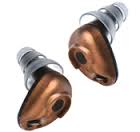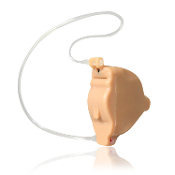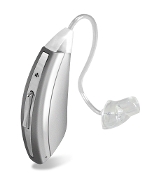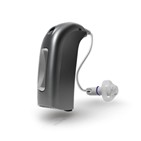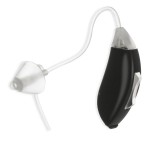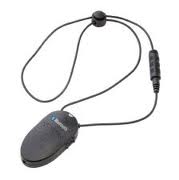In my last two blog posts, “When is a hearing aid not a hearing aid?” and “Personal Sound Amplification Products – PSAP’s,” I have been discussing ear-level amplification products that are sold online or over-the-counter. The products listed below are all FDA approved hearing aids. I have been researching these products for the purpose of learning about them and sharing this information with you; however, as I stated in my previous post, anyone who suspects they have a hearing loss should see an ENT. There may be a serious medical condition causing the hearing loss or there may be a simple problem such as wax in the ears. This should always be the first step in searching for a solution to hearing loss. I also believe that whenever possible, a hearing aid should be purchased from an audiologist.
The reasons for purchasing a hearing aid from an audiologist are well-stated in this article by David Kirkwood: “AAA kit helps audiologists make the case against direct-to-consumer hearing aid sales.”
“Hearing aids are medical devices regulated by the Food and Drug Administration (FDA) and must be recommended and prescribed by licensed professionals. This standard is in place to protect the individual with hearing loss, as not all individuals are candidates for amplification.
Additionally, an improperly fit hearing aid or hearing aid sold online without a face-to-face evaluation with an audiologist can potentially cause various problems. Without a face-to-face evaluation, the consumer will not have an otoscopic evaluation (have the audiologist look into the ear canal) and medical problems such as ear drainage or ear blockages which can cause hearing loss will not be identified.
Additionally, hearing aids that are not adjusted to the individual needs of the patient have the potential for increasing the hearing loss if the devices are not set appropriately. Lastly, audiologists can tailor a comprehensive treatment plan for each individual patient so as to ensure maximum performance from any device that may be prescribed.”
Having said that, the fact is that hearing aids are very expensive. People are looking for alternatives. I have gathered the following information from the websites and talking to customer service representatives. If you find any information that is inaccurate, please let me know and I will correct it. I have highlighted some important features in these hearing aids such as t-coils, Bluetooth and analog models (some people prefer analog to digital). Note that some of these hearing aids are programmed to your hearing loss and others are not.
1. General Hearing Instruments, Inc. range from $344 – $399 each
1-800-824-3021 (M-F 7:00am – 6:00pm CST)
http://www.generalhearing.com/
No custom programming.
3 digital models – Simplicity (behind-the-ear), Simply Soft (in-the-ear), and Simply Slim (in-the-ear)
Hi Fidelity model is analog.
4 pre-set amplification programs
Sold online at samsclub.com, walmart.com, sears.com
No t-coils.
90-day money back guarantee; 1-year manufacturer warranty, extended warranty available.
2. Embrace Hearing, range from $400 – $950 each
1-917–830-HEAR (4327) (M-F 9:00am – 6:00pm EST)
http://www.embracehearing.com/
Send your audiogram and they program it.
3 behind-the-ear (BTE) models: Embrace Base, Embrace X-mini, Embrace Luna.
The Embrace Base is $399, has 2 programs and a t-coil
The X-mini is $599, has 4 programs, and receiver-in-the-canal (RIC) technology, No t-coil. Basic remote available for $99.
The Luna model is $949, has 6 programs, and has a t-coil, receiver-in-the-canal (RIC) technology and Bluetooth connectivity with Bluetooth remote $299.
45-day money back guarantee; 2 or 3-year manufacturer warranty.
One free reprogramming in the 45-day trial period if you are unhappy with the initial programming.
3. MD Hearing, range from $120 – $350 each
1-888-670-HEAR (4327) 24 hours/7 days/week
http://www.mdhearingaid.com/
No custom programming.
3 behind-the-ear models, Air, Pro, and Max.
The Air model is $399.99, has 4 preset programs including a t-coil, and volume control.
The Pro model is $179.99, is analog, has 2 preset programs, and volume control,
The Max is $119.99, has a volume control and is a receiver-in-the-ear (RIE) model. Designed for someone who can’t manipulate small controls..
45-day money back guarantee; 90-day manufacturer warranty; extended warranty available.
4. Audicus, range from $499 – $649 each
1-888-979-6918 (M-F 9:00 – 6:00 EST)
http://www.audicus.com/
Send your audiogram and they program it.
6 models: “aBlue,” “aSamba,” “aPearl,” aNote,” “aSwing,” and “aSoul,”
(and “aJive” which is a PSAP, not a hearing aid)
See their website for features. Not all models are listed on home page. Use the search box to find details of each model. Of note is the aBlue and the ASwing.
The aBlue model is $599, behind-the-ear (BTE) style. It has Bluetooth connectivity when used with the Bluetooth controller for $299. The Bluetooth controller comes with a Bluetooth transmitter that may be used on the TV and other audio devices.
The “aSwing” is $499, BTE style and has a t-coil.
45-day money back guarantee; 1-year manufacturer warranty; extended warranty available.
Free programming adjustments for the lifetime of the product.
5. hi Health Innovations range from $749 – $949 each
1-855-523-9355 (M-F 9:00am – 5:00pm CST)
https://www.hihealthinnovations.com/
Send your audiogram and they program it.
4 models – hi-ITC, hi BTE mini, hiBTE, hiBTE power
Each model has 3 programs and a volume control.
The hiBTE model has the option of a t-coil and the hiPTE power comes with a t-coil.
70-day money back guarantee; 1-year manufacturer warranty.
If you have tried any of these products or other hearing aids sold online, please leave a comment and let us know how you liked them.
Filed under: Uncategorized | 7 Comments »



